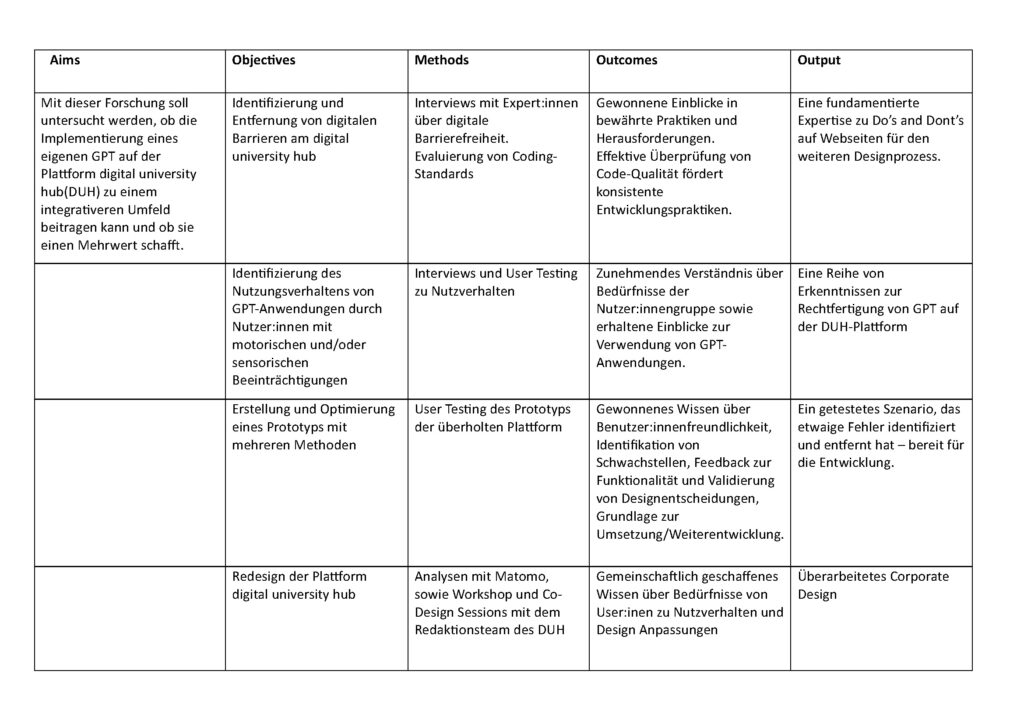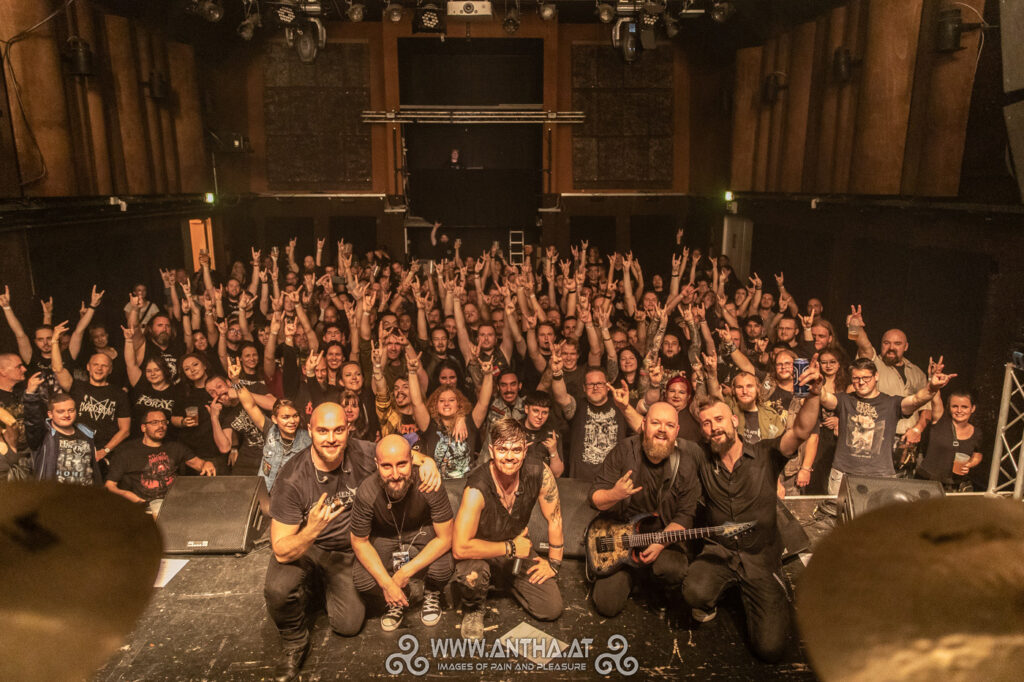@Birgit Bachler
Research Planing Matrix: “Aim: change color of car black”

Joke aside.
Research Matrix for the relaunch of the digital university hub

@Birgit Bachler

Joke aside.

Online webinar by Fairygodboss [1]
Recently I watched a webinar hosted by Fairygodboss [2], featuring women leaders from Siemens Digital Industries Software. Fairygodboss is an online community designed for women to share their experiences, ask for advice, and get resources to help in navigate challenges in the professional sphere. The focus was on supporting young women in their career start and development.
The leaders from Siemens Digital Industries Software started by talking about diverse roles available for women within their organisation and talked about what main features those have. What I think was helpful within this webinar, which women can use, was them talking about how they started looking for a job after graduating. Four women professionals were talking about the details of their jobs, how they were being interviewed, and what challenges they had. They also advised on what questions are important to be asked during interviews, what should be prepared, etc. During the webinar, mentorship appeared as a crucial topic in the area, as many women feel too intimidated when it comes to their proficiency and/or knowledge.
In conclusion, this webinar was a helpful experience, as it not only showed guidance for women in the professional sphere but also the importance of such platforms.
Being on a journey of searching for the right topic and question for my master’s thesis that I would want to explore was quite difficult for me because there were different things and ideas, that were interesting to me, and a lot of thoughts about them on my mind. For me the important part of it was to have something that matters and would be helpful as well.
What helped me to “clean up” all my thoughts and confusion was the last meeting with Ursula Lagger and after that, I decided to focus more on what outcome or experience I would want to provide for others with my idea. Based on the research I did and also on the previous ideas I had, I decided to work with the question: How does participation in a women-centric career empowerment platform influence career advancement, job search, and satisfaction among women?
With this, I hope to explore what experience women have when starting their careers, what helped to build careers for those who are already working; show the positive changes that occur when women support and empower each other and create a supportive environment in the professional sphere.
Der Artikel “Diversity in Graphic Design” von Rodney Ross behandelt das Problem des Mangels an Vielfalt in der Grafikdesignbranche. Ross argumentiert, dass die fehlende Repräsentation von Minderheiten einen erheblichen Einfluss auf die Glaubwürdigkeit und kreative Bandbreite des Feldes hat. Er betont, dass eine vielfältigere Belegschaft notwendig ist, um den sich verändernden Bedürfnissen einer zunehmend diversen Gesellschaft gerecht zu werden.
Ross zeigt auf, dass die USA eine rapide wachsende Vielfalt aufweisen, wobei Nicht-Weiße bis 2050 voraussichtlich über 50 Prozent der Bevölkerung ausmachen werden. Dennoch bleibt die Grafikdesignbranche stark von weißen Amerikanern dominiert, was zu einer Verzerrung der kreativen Perspektiven führt.
Der Artikel skizziert auch die historischen Wurzeln dieses Mangels an Vielfalt, insbesondere im Kontext der Bürgerrechtsbewegung. Er argumentiert, dass institutioneller Rassismus und strukturelle Barrieren schwarze Amerikaner und andere Minderheiten davon abhielten, in die Grafikdesignbranche einzutreten und sich dort zu etablieren.
Ross identifiziert Stereotypen als ein weiteres Problem, das durch den Mangel an Vielfalt in der Branche verstärkt wird. Er weist darauf hin, dass Designentscheidungen oft unbewusst kulturelle Vorurteile widerspiegeln und dass die fehlende Vielfalt in den Designteams dazu führen kann, dass diese Vorurteile verstärkt werden.
Um das Problem anzugehen, schlägt Ross verschiedene Maßnahmen vor, darunter die Förderung von Vielfalt in Designschulen, die Schaffung von Arbeitsplätzen und Karrieremöglichkeiten für Minderheiten in der Branche sowie die Sensibilisierung für kulturelle Stereotypen und Vorurteile.
Der Artikel schließt mit einem optimistischen Ausblick auf die Zukunft der Branche, wenn das Problem der Vielfalt angegangen wird. Ross argumentiert, dass eine vielfältigere Grafikdesignbranche zu einer höheren Qualität und einem breiteren kulturellen Verständnis in der Arbeit führen würde, was letztendlich zu einem positiven Einfluss auf die Gesellschaft insgesamt führen könnte.
Der Artikel bietet eine umfassende Analyse des Problems der mangelnden Vielfalt in der Grafikdesignbranche und bietet eine Vielzahl von Quellen und Beispielen, um seine Argumentation zu stützen. Er behandelt verschiedene Aspekte des Themas, einschließlich historischer Hintergründe, Auswirkungen auf die Gesellschaft und Lösungsansätze.
Die Auseinandersetzung mit diesem Artikel zeigte mir wieder, wie wichtig die Auseinandersetzung mit diesem Thema ist.
Link zum Artikel:
Weitere spannende Ressourcen und Artikel von AIGA:
https://www.aiga.org/resources/diversity-inclusion-books-and-articles
Elena Waschl | 3. Semester Communication Design | unterstützender Post zur Masterarbeit
Zusammenfassung vom Buch “Design for the Real World” von Victor Papanek (Teil 2)
Quelle: Papanek, V., & Fuller, R. B. (1972). Design for the real world. > used the third edition
PART TWO:
Die wichtigste Fähigkeit eines Designers ist: recognise, isolate, define and solve problems!
Das heißt wir müssen uns für Probleme sensibilisieren. “Discover the problem that now one
Wie wir denken…
… analytisch = wie lange fahre ich von A nach B
… judgmental = welches ist das beste der drei?
… routine = how cold is it, what should i wear?!
… creative = like a spark of a genuis, sometimes during dreams
Wir Menschen sind Meister in Regeln und Verbote aufstellen!
Standards und Behaviour Rules, um eine Übereinstimmung mit der Masse zu erreichen. Dies passiert meist durch mass-media, advertising, production and automatisierung
“Dabei versuchen wir uns zu schützen, um nicht von der Norm abzuweichen”, aber gleichzeitig hemmt dieses Verhalten auch Innovation, Kreativität, kritisches Denken!
Auch kulturelle Entwicklungen machen andere Entwicklungen schwierig.
a. Die Fähigkeit Probleme zu lösen in einem unerwarteten Weg ist zu einer Rarität geworden!
b. die schnelllebige Zeit, Designer können komplexe Probleme nur durch neue Insights lösen, es ist umso wichtiger interdisziplinär zu arbeiten!
c. Design Studenten lernen nahezu keine Methoden neue Insights zu generieren!
Problem solve methods:
“The tree of knowledge”
Eine Ressource die scheinbar unermüdlich Lösungen bereit hält ist das Handbuch der Natur.
Die Fünf Mythen:
Die Umwelt wird ausgeraubt für unser Design
Wir müssem das Konzept von Transporatation Rethinken!
Design Education:
Education is based on learning skills, nourishing talents and undersatnding theories and concepts. Aber wir lernen oft Dinge die längst aus der Zeit gefallen sind oder einfach nicht den Standards (der Zukunft entsprechen)
Wir lernen am effizientesten unter Einsatz von interaktiven Systemen die uns gleich feedback geben. Dabei ist es wichtig dass das Feedback informiert über den Stand des Prozesses und in welche Richtung es weiter gehen soll.
The main trouble in design school is to teach too much design and not enough about the ecological, social economic and political environment in which design takes place! We need to deal with design process comprehensively. But we also need to look into the history and learn from the past. All the design is an extension of human being. All design must fill a human need. This needs must be also seen as cultural changes. Another consideration must be that of human and humane factors. The relevance of values is obvious.Design must be recognizeable and usable NOT only for five human senses also by the inner senses both psychological and kinesthetic. Also of inner and outer perception.
Pattern and values changes, long term sense get relevant,
Finally design also needs to consider social groups / status, classes and societies.
Students müssen angespornt werden to travel widely and work in many different fields, not only design, sondern auch in der Industrie, auf Farmen, Factories,etc.! Es ist essentiell in interdisziplinären Teams zu arbeiten aus verschiedenen Kulturen.
“Good taste is an invention of merchants, design and folk art don´t have it. good taste is create fashion for profit”
The task is to research our true needs and reshaoe environments, tools and the way in which we think about them.
Links:
https://en.wikipedia.org/wiki/Victor_Papanek
https://papanek.org
Elena Waschl | 3. Semester Communication Design | unterstützender Post zur Masterarbeit
Zusammenfassung vom Buch “Design for the Real World” von Victor Papanek (Teil 1)
Allgemein:
“Design for the Real World” von Victor Papanek, erstmalig veröffentlicht im Jahr 1971, ist ein grundlegendes Werk im Bereich des sozial und ökologisch verantwortungsbewussten Designs. Papanek, ein österreichisch-amerikanischer Designer und Pädagoge, kritisiert in seinem Buch die Designbranche dafür, dass sie zu stark kommerziell ausgerichtet ist und oft die wahren Bedürfnisse der Menschen und die Umweltauswirkungen ignoriert.
Die Hauptthesen des Buches lassen sich wie folgt zusammenfassen:
“Design for the Real World” ist weit mehr als ein Designbuch; es ist ein Aufruf zum Handeln und ein Plädoyer für eine menschenzentrierte und ethisch verantwortungsbewusste Designpraxis. Das Buch hat seit seiner Veröffentlichung Generationen von Designern beeinflusst und gilt als ein Pionierwerk in den Bereichen des nachhaltigen und humanzentrierten Designs.
Taking notes, relevante Notizen vom Buch
INTRO:
Nur wenige andere Berufe sind so “schädlich” wie die eines Industrie Designers. Sie schädigen Mensch und Umwelt.
Design ist eines der machtvollsten Werkzeuge, welches Gesellschaft, Umwelt und auch den Menschen formen. Deswegen müssen wir die Verantwortung sehen.
Advertising Design is persuading people “Dinge zu kaufen die sie nicht brauchen mit Geld dass sie nicht haben, um Menschen zu beeindrucken die sich nicht für sie interessieren.”
Wirhaben bereits so viele Designbücher die uns erklären: “How to do Design”, aber wir als Designer müssen die Hintergründe verstehen. Wir müssen uns in so viel mehr Bereichen auskennen wie im sozialen, Politik, Wirtschaft, etc.
“Something is basically wrong with the concept of pattents and copyrights! “
Intelligent: Dialog between Designer & Consumer!
PART ONE:
What is design?
“Design is conscious and intuitiv effort to impose meaningful order”
Wir können nicht davon ausgehen, dass “everyday objects” ohne Kontext in verschiedenen Gesellschaften und Kulturen gleich funktionieren. Es ist wichtig die Menschen zu verstehen die, die Produkte schlussendlich verwenden.
Viele Werte basieren auf Traditionen und gelebte Werte innerhalb von Kulturen.
Wir werden größtenteils unbewusst zum passiven Konsum durch Werbung getrieben.
The real needs in einem Projekt werden oftmals vernachlässigt.
Design muss die Vergangenheit verstehen, um die Zukunft zu gestalten! Die Konsequenz seines Designs bewusst sein.
Design geschieht oft auf Basis von Marktorientierung und ist ein profit gesteuertes System.
Links:
https://papanek.org/archivelibrary/victor-papanek/
https://www.design-museum.de/de/ausstellungen/detailseiten/victor-papanek-the-politics-of-design.html
https://www.dieangewandte.at/publikationen/design_for_the_real_world_human_ecology_and_social_change
In der stillen Umgebung der Garage erwacht der Ford Bronco mit einem beeindruckenden Klang, der die Luft erzittern lässt. Der Moment, in dem der Motor zum Leben erweckt wird, ist mehr als nur ein einfacher Startvorgang, es ist eine akustische Symphonie der Kraft. Das tiefe Brummen des Motors durchdringt die Stille, ein basslastiges Grollen, das die Sinne erfasst und die Atmosphäre mit einem Hauch von Abenteuer erfüllt.
Der Sound des Ford Broncos beim Starten ist keine bloße Lärmerzeugung; es ist eine musikalische Komposition aus kraftvollen Vibrationen und tiefen, gurgelnden Tönen. Die Auspuffrohre singen eine kraftvolle Melodie, die das Herz schneller schlagen lässt und eine Vorfreude auf die Straße weckt. Es ist, als ob der Bronco selbst eine Geschichte erzählt, eine Geschichte von Freiheit und ungebändigter Power.
Der Klang des gestarteten Ford Broncos in der Garage ist mehr als nur ein Geräusch, er ist ein Erlebnis, das die Leidenschaft für Abenteuer und die Liebe zur Fahrt in jedem einzelnen Ton widerspiegelt. Es ist der Sound der Freiheit, eingefangen in einem automobilen Meisterwerk.

Schweißen ist eine Symphonie aus Zischen und Funken, eine Kakophonie, die mit der Energie des miteinander verschmelzenden Metalls mitschwingt. Das scharfe Knistern des Schweißlichtbogens, ähnlich den Eröffnungsakkorden einer industriellen Ouvertüre, durchdringt die Luft. Wenn das geschmolzene Metall auf seinen Gegenspieler trifft, entsteht ein rhythmisches Zischen – eine Verschmelzung von Wärme und Material, die sich gleichzeitig verwandeln.
Das ständige Spritzen geschmolzener Tröpfchen erzeugt einen unregelmäßigen Schlag, der den Fortschritt des Schweißers unterbricht. Das gleichmäßige Summen der Schweißmaschine sorgt für die Grundlinie, eine konstante Vibration, die die dynamische Verschmelzung von Metall unterstreicht. Das hohe Jammern des Schweißdrahtes, der sich über das Werkstück bewegt, verleiht der Klangkomposition eine melodische Note.
Inmitten dieser metallischen Symphonie erzeugt die vom Schweißer getragene Schutzausrüstung ihre ganz eigenen, einzigartigen Geräusche – das Klirren von Metall auf Metall und die gedämpften Echos des Atems durch die Maske. Der beißende Geruch von brennendem Metall durchdringt die Luft und verleiht dem Hörerlebnis eine sinnliche Dimension.
Das Geräusch beim Schweißen ist nicht nur Lärm; Es ist eine auditive Erzählung von Handwerkskunst, ein Beweis für die transformative Kraft von Wärme und Präzision. Die Symphonie des Schweißens mit ihrem Knallen, Zischen und Knistern schafft eine Industrialsonate, einen musikalischen Abdruck der Metal-Metamorphose.
LINKS

Bei einem Metal-Konzert auf der Bühne zu stehen, ist ein viszerales Eintauchen in einen Klangsturm, ein Sinnesangriff, der die Grenzen zwischen Musiker und Publikum überschreitet. Das Dröhnen der Verstärker und der donnernde Schlag der Trommeln verschmelzen zu einer Klangwand, die jeden Zentimeter der Bühne einhüllt. Die elektrische Energie verzerrter Gitarren strömt durch die Luft und pulsiert mit einer rohen Intensität, die zu einer spürbaren Kraft wird und durch Ihre Adern fließt.
Die Reaktion des Publikums, eine Mischung aus Schreien und Faustschlägen, hallt als lebendiges Echo wider und wirkt sich auf die Aufführung aus. Die Bühne selbst scheint unter Ihren Füßen zu vibrieren und mit dem kollektiven Herzschlag der in klanglicher Gemeinschaft vereinten Metalheads mitzuschwingen. Die blendenden Lichter, synchronisiert mit dem pochenden Rhythmus, erzeugen eine visuelle Symphonie, die den akustischen Ansturm verstärkt.
Als Musiker ist das Gefühl transzendent, ein symbiotischer Tanz mit der Musik und dem Publikum. Die Hitze der Bühnenbeleuchtung, das durch Ihren Körper strömende Adrenalin und die schiere Klangkraft erzeugen einen berauschenden Cocktail aus Emotionen. Die Vibrationen der Bassfrequenzen werden zu einer körperlichen Liebkosung und lassen Sie in einen Strudel aus Klängen eintauchen.
Jede gespielte Note wird nicht nur gehört, sondern gefühlt – eine viszerale Verbindung, die über das Hörbare hinausgeht. Es ist eine Verschmelzung von Klang und Emotion, eine alchemistische Reaktion, bei der die Bühne zu einem heiligen Raum und die Musik zu einer elementaren Kraft wird. Bei einem Metal-Konzert auf der Bühne zu stehen, ist nicht nur ein Auftritt. Es ist eine immersive Reise in das Herz der Klangrebellion.
LINKS


Die Symphonie einer Tunnelbohrmaschine (TBM) ist ein Wunderwerk der Ingenieurskunst, eine orchestrierte Kakophonie, die durch die Erde hallt, während sie sich ihren Weg unter der Oberfläche bahnt. Als der massive Schneidkopf auf den Boden trifft, ertönt ein niederfrequentes Summen, das den Beginn des unterirdischen Balletts signalisiert.
Die rhythmischen Vorstöße der TBM erzeugen einen gleichmäßigen Schlag, einen mechanischen Herzschlag, der durch die Tunnelwände hallt. Das Knirschen der Zähne des Fräsers gegen Gestein und Erde erzeugt eine metallische Melodie, einen anhaltenden und entschlossenen Soundtrack für den unerbittlichen Vormarsch der Maschine. Jede Drehung des Schneidkopfes wird von einer Symphonie aus Klirren und Schlägen begleitet, ein Beweis für die gewaltige Kraft, die zum Ausheben der unterirdischen Landschaft erforderlich ist.
Die Hydrauliksysteme verleihen der Komposition ihre eigene Stimme, wobei das Rauschen unter Druck stehender Flüssigkeiten und das Summen der Motoren für eine dynamische Harmonie sorgen. Während sich die TBM langsam vorwärts bewegt, erzeugen die Schlammförderbänder einen rhythmischen Förderbandrhythmus und transportieren das Aushubmaterial in einem synchronisierten Effizienztanz an die Oberfläche.
Gelegentliche Druckluftstöße untermalen die Geräuschkulisse, während die Bediener der TBM die Umgebung im Tunnel strategisch steuern. Die akustischen Alarm- und Warnsignale werden zu einem integralen Bestandteil der Maschinensprache und sorgen für Sicherheit inmitten der mechanischen Symphonie.
Das Geräusch der Tunnelbohrmaschine ist nicht nur Lärm. Es ist eine hörbare Erzählung menschlichen Einfallsreichtums, eine Underground-Oper, die sich mit Präzision und Kraft entfaltet. Dieses unterirdische Konzert mit seinen industriellen Ouvertüren und weltbewegenden Harmonien ist ein Beweis für die bemerkenswerte Verbindung von Technologie und den Urkräften der Erde.
LINKS

